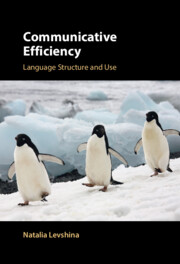Book contents
- Communicative Efficiency
- Communicative Efficiency
- Copyright page
- Dedication
- Contents
- Figures
- Tables
- Preface
- Acknowledgements
- Abbreviations
- Part I Different Types of Efficiency in Language
- Part II Efficiency and Language Evolution
- Part III Case Studies
- 7 Efficient Form–Meaning Mapping in Causative Constructions
- 8 Differential Case Marking and Efficiency
- 9 Efficient Use of Function Words in English Alternations
- 10 Conclusions and Perspectives
- Appendices
- References
- Index
10 - Conclusions and Perspectives
from Part III - Case Studies
Published online by Cambridge University Press: 03 November 2022
- Communicative Efficiency
- Communicative Efficiency
- Copyright page
- Dedication
- Contents
- Figures
- Tables
- Preface
- Acknowledgements
- Abbreviations
- Part I Different Types of Efficiency in Language
- Part II Efficiency and Language Evolution
- Part III Case Studies
- 7 Efficient Form–Meaning Mapping in Causative Constructions
- 8 Differential Case Marking and Efficiency
- 9 Efficient Use of Function Words in English Alternations
- 10 Conclusions and Perspectives
- Appendices
- References
- Index
Summary
This chapter provides a summary of the main findings reported in this book and discusses numerous questions for future research. It also addresses the political aspects of communicative efficiency and contemplates the potential impact of new technologies on costs of language communication.
- Type
- Chapter
- Information
- Communicative EfficiencyLanguage Structure and Use, pp. 245 - 249Publisher: Cambridge University PressPrint publication year: 2022

